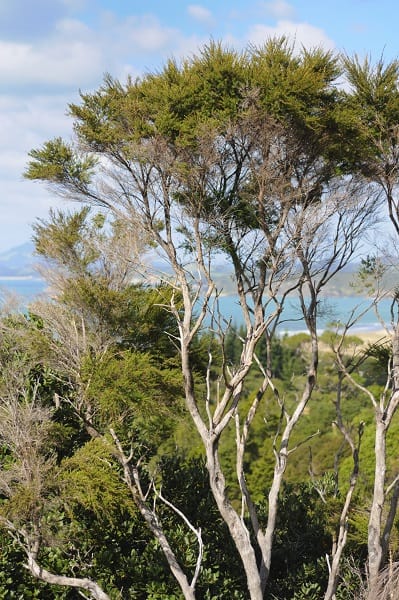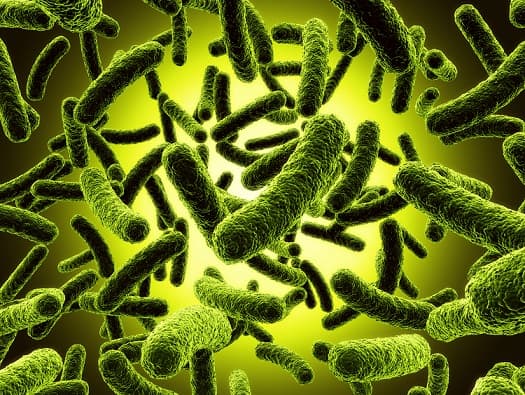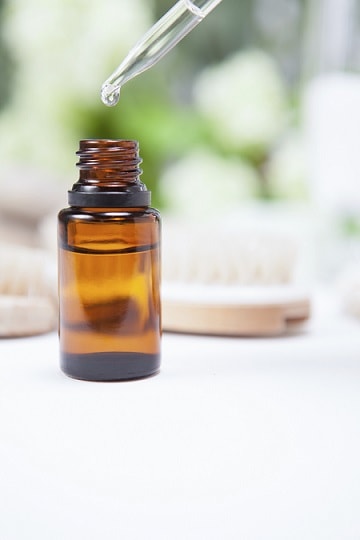 Tea tree oil is a pale yellow to nearly clear oil extracted from the leaves of the Melaleuca alternifolia plant from Australia.
Tea tree oil is a pale yellow to nearly clear oil extracted from the leaves of the Melaleuca alternifolia plant from Australia.
For centuries, Aboriginals along the east coast crushed the leaves into a paste and used it dress wounds, to prevent bacterial infection. Later, the oils were extracted from the leaves and used against a sore throat or cough.
Today, tea tree oil is still a staple in the cupboards of many natural remedy lovers. Its antibacterial properties are legendary, whether it’s against athlete’s foot or atopic dermatitis…
…and luckily for us, tea tree oil is a highly underrated topical acne treatment.
Supported by an avalanche of evidence
Firstly, we have this February 2015 review from the International Journal of Antimicrobial Agents, which compiled several scientific studies performed between 2005 and 2014. Overall, products infused with tea tree oil slashed acne lesions by at least 23.7%, and up to 62.1%.
Take a look at these specific studies:
ONE: a double blind experiment from 2007, which gathered 60 patients with mild to moderate acne. They were randomly divided into two groups of 30, and given either a placebo or a 5% tea tree oil gel. Both total lesions count (TLC) and the acne severity index (ASI) were used as measurements.
There were no significant differences in age, gender, nationality, or other demographic characteristics. Nevertheless, after 45 days, the tea tree oil patients enjoyed far faster reductions in acne.
Tea tree oil gel was 3.55 times and 5.75 times more effective than placebo at reducing TLC and ASI respectively. The scientists concluded that “topical 5% tea tree oil is an effective treatment for mild to moderate acne vulgaris”.
TWO – in a 2002 experiment, 27 patients were injected with the immune system agent histamine, in order to induce inflammation in their skin. After 20 minutes, 21 patients received 100% tea tree oil, while the other 6 received paraffin oil.
The paraffin failed to calm the inflammatory redness and swelling, but tea tree oil succeeded within 10 minutes. That’s excellent news, because acne is an inflammatory disease at its root.
Then you have the superb user reviews to consider. On acne.org, tea tree oil receives a user score of 4.1/5, and 87% of users would recommend it to a friend.
It’s true that user reviews for acne products can be tainted by overoptimistic ideas, and businesses simply planting stories to gain publicity and sails. Nevertheless, this is a promising sign, and some particularly epic tales include…
- A reduced lifespan of acne, as tea tree oil dried out active pimples rapidly.
- Acne which went away within 24 hours of exposure.
- A “giant, angry pimple” which calmed down massively overnight.
- Clearing angry acne when nothing else worked.
The consensus is clear – tea tree oil is superb at calming down the fieriest, most aggressive acne.
Almost matches BP, without the side effects!
Meanwhile, a 1990 study compared tea tree oil to benzoyl peroxide, the nuclear weapon of pharmaceutical acne treatments which is constantly dished out by doctors. The study found that 5% concentration tea tree oil killed acne almost as effectively as 5% concentration BP. That’s a similar concentration to BP creams found in shops, including Oxy-5 and Benzac AC.
According to the study, tea tree oil cleared acne more slowly over the 3 month study, but BP was significantly more irritating to the face. 79% of benzoyl peroxide users experienced side effects, versus 44% for tea tree oil, with the most common one being dryness, followed by stinging and burning. The study had a decent sample size, involving 58 patients using tea tree oil and 61 controls using BP.
Read Annihilate Your Acne – learn how to clear your skin permanently
Benzoyl Peroxide is constantly hyped up, but its mechanism is pure brute force, blasting p.acnes bacteria with free radicals to destroy them, which can simultaneously damage your healthy cells. Its side effects are notorious, including burning of the skin, redness, and peeling. The side effects of tea tree oil are actually similar, but far milder, according to studies.
Individual allergic reactions can happen, as can stronger reactions among sensitive skin. But unlike benzoyl peroxide, where it’s a game of Russian roulette every time, tea tree oil relies on more subtle antibacterial compounds to perform its work…
The acne science behind tea tree
 Tea tree oil has endless compounds, and the most famous is Terpinen 4-ol, a terpene antioxidant which also appears in small quantities in nutmeg.
Tea tree oil has endless compounds, and the most famous is Terpinen 4-ol, a terpene antioxidant which also appears in small quantities in nutmeg.
Many of tea tree oil’s famous attributes come from its antibacterial powers, such as disinfecting wounds. Terpinen 4-ol can inhibit endless strains, and according to this study, it wages war on Staphylococcus aureus, S. epidermidis, and Propionibacterium acnes (acne bacteria) specifically. They concluded that “This study supports the use of tea-tree oil in the treatment of acne“. It doesn’t get much better than that.
Apply tea tree oil, and your acne bacteria will be crippled, preventing the immune system assault which unleashes so much acne chaos. While terpinen 4-ol is the best researched, two additional tea tree oil compounds called alpha-terpineol and alpha-pinene inhibited p.acnes just as excellently.
Recommended – 6 vitamins and minerals which could finally clear your acne
Just review the other abilities of tea tree oil: it’s famous for treating atopic dermatitis, ringworm, and athlete’s foot, all of which are connected to bacterial overgrowth. The dentists and surgeons of the 1920s used it for sterilising wounds and infections. This remedy can even inhibit the dreaded Methicillin Resistant Staphylococcus Aureas (MRSA), a resistant microorganism which infects scores of hospital patients yearly.
It’s clear that tea tree oil is an antibacterial juggernaut, just like raw honey.
Tea tree oil has localised anti-inflammatory powers
 Terpinin-4-ol can also soothe inflammation, as shown by a 2000 study which applied it topically to human cells. TNF alpha, IL-1beta and IL-8, some of the worst chemicals for inflaming your acne, all fell by 50%.
Terpinin-4-ol can also soothe inflammation, as shown by a 2000 study which applied it topically to human cells. TNF alpha, IL-1beta and IL-8, some of the worst chemicals for inflaming your acne, all fell by 50%.
Two other compounds, a-terpineol and 1,8-cineole, were examined, but terpinen 4-ol was the most powerfully anti-inflammatory. The gigantic 50% reduction was achieved after 40 hours of exposure, so you could easily achieve good results after just ten hours in bed at night.
A 2014 study then tested whole tea tree oil, and again caused a large reduction in inflammatory villains such as IL-6.
To cure acne, you have to learn the dietary tricks which calm chronic inflammation across your whole body. Slashing sugar is a great place to start. However, lowering skinflammation directly is also smart, and terpinin-4-ol seems excellent at doing that.
How to use tea tree oil
What’s important, however, is to use only a small dosage. All tea tree oil contains varying amounts of a skin irritant called 8–cineole which some skin types react particularly badly to. These rashes are usually mild and itchy, but can develop into blisters.
Occasionally, this compound causes serious allergic reactions. Such reactions aren’t common, but slather tons of oil on yourself and they will be. Treat this powerful natural substance with respect!
Secondly, the internet is littered with stories where acne patients tried applying tea tree oil to their entire skin, to prevent breakouts altogether. They were shocked to wake up to rashes and in some cases, painful blisters. Some people even “grew” acne in areas where they’d never had it before.
Therefore, the ultimate strategy is to only apply tea tree oil to individual red and swollen pimples. Lowering inflammation and suppressing p.acnes bacteria is where tea tree oil shines, not as a general skin enhancer.
Tea tree oil is best as an acne killing tool, whereas for acne prevention, you need something milder like grapeseed oil.
The best tea tree oil product for acne
Firstly, there’s many tea tree oil products that use the name purely for marketing value rather than real effectiveness. According to one study:
- “Tea tree oil may be included as the active therapeutic agent or at lower levels that are unlikely to have therapeutic benefit but instead serve to increase the appeal or marketability of the product.”
In other words, a bottle boasting of “natural Australian tea tree” is often designed to enrich not your skin, but rather the manufacturer’s bank account. Some bottles aren’t even extracted from the correct species: you should always purchase Melaleuca alternifolia and nothing else.
Here are some other ways to make your tea tree oil unstoppable against acne:
Buy a pure, 100%, organic bottle. Simply buy raw, undiluted tea tree oil. Don’t bother with creams or soaps, which often contain only minuscule quantities. Using full 100% strength is a recipe for irritation, so it’s best to dilute the solution in water first, and then apply to a cotton puff.
7 natural topical treatments which can massively reduce acne
Buy a dark bottle. This prevents sunlight from oxidising the oil. When exposed to light, terpinen 4-ol rapidly breaks down and becomes useless for acne. Worse, UV light increases a hydrocarbon called para-cymene, a known skin irritant. Oxidised tea tree oil causes more allergic reactions, and the same is true for lavender oil.
Perform an allergy test. There are some unlucky souls who cannot tolerate tea tree oil at all. To test your own reactions, a smart strategy is to dilute some tea tree oil with water and dab a small quantity on your arm. If your skin suddenly reddens and rashes, then you have an unfortunate sensitivity. If not, you’re good to go.
Check the concentration of terpinen 4-ol. These days, any tea tree oil company worth its salt analyses their product in a laboratory and displays the terpinen-4-ol percentage on the bottle. Over 40% is ideal, and the quantities must be above 30%. If a bottle doesn’t display the percentage, then that’s your sign to run far away. The best companies have GC/MS lab reports available for viewing on their websites (like Eden’s Garden).
Get the finest from Australia. The real tea tree plant grows in Australia. Check the bottle or sales page for “sourced from Australia”, or something similar.
A product which fulfils all those requirements is this Eden’s Garden Tea Tree Oil (amazon link). The bottle is dark, and the terpinen-4-ol content is consistently over 40% in lab reports (viewable here).
Conclusion – tea tree oil is a great topical acne treatment
Tea tree oil is a natural acne treatment that seems to work excellently. It thrashes BP, as despite being slower to calm pimples, it’s far less likely to backfire and cause new acne.
5% concentration is optimal, as that’s what the two direct studies on acne used. Of course, topical treatments will never succeed alone, because acne starts inside the body. You have to change your diet and lifestyle.
However, tea tree oil is an excellent short term solution, for desperately calming an angry pimple on the night of a hot date or important business meeting.
The journey continues: lemongrass oil
Tea tree is a famous essential oil, which you’d probably heard of long before acne darkened your doorstep. However, the most promising obscure essential oil is probably lemongrass oil.
This remedy is a distillation of the leaves and stems of the lemongrass plant, a 6 foot high clump of lemon-scented grass which grows in tropical climates. In traditional Sri Lankan and Indian villages, lemongrass tea is known as fever tea, since that’s what they drink it for.
For acne, it crippled p.acnes bacteria in a 2007 study. 22 essential oils were tested in total, but lemongrass oil began inhabiting p.acnes at the lowest concentrations (0.125%) alongside citronella oil. Citral was probably responsible, as this is the active compound of lemongrass oil (comprising 70%).
That’s a similar power to tea tree oil then, but a rarer power is inhibiting neutrophils on the skin’s surface, a pro-inflammatory immune system agent which releases bursts of destabilising free radicals. Neutrophils are often recruited to action by other inflammatory chemicals, and lemongrass oil was the strongest at inhibiting this, according to a study comparing 10 different essential oils. Lemongrass oil required concentrations of just 0.00625%, while the runners up, geranium oil and spearmint oil, required 0.013% and 0.016% respectively.
Increasing neutrophils is believed to be why the bipolar medication lithium causes acne constantly. If a targeted topical treatment can curtail levels, then that’s excellent news. Lemongrass is another acne remedy to watch, with a different profile (and therefore different potential) to tea tree oil.
NEXT: forget creams and moisturisers – discover the ultimate acne-clearing diet
Thanks for reading!
